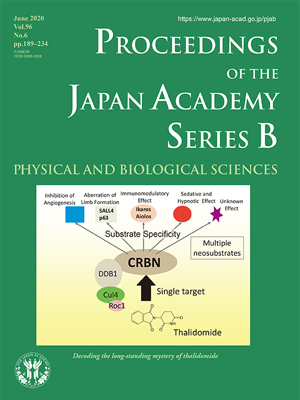About the Cover
Vol. 96 No. 6 (2020)
In general, an effective drug selectively and directly binds to its target protein with high affinity to exert a pharmaceutical effect. Hiroshi Handa and his colleagues previously developed an affinity bead technology to efficiently isolate drug-binding proteins, including the target, directly from protein libraries. Thalidomide, a drug that was once excluded from the market owing to its teratogenic activities, was subsequently found to be effective for the treatment of multiple myeloma (MM). However, little was known about the mechanisms involved in the actions of thalidomide, regarding both its beneficial effects and harmful side effects. Dr. Handa’s group identified cereblon (CRBN) as the primary target of thalidomide using their affinity bead technology and found that CRBN is a substrate receptor of the E3 ubiquitin-ligase complex, cullin RING ligase 4 (CRL4CRBN), consisting of DDB1, Cul4A or 4B, and Roc1 (see the review article in this issue, pp. 189-203). They constructed a CRBN mutant deficient in thalidomide binding by replacing both tyrosine 384 and tryptophan 386 with alanine, which was otherwise functional. The double-point mutant suppressed the thalidomide-induced embryopathy of the pectoral fins and forelimbs of zebrafish and chickens, respectively, as well as suppressed the downregulation of FGF 8 expression, which is essential for the early development of the fins and forelimbs. Their findings revealed CRBN to be a genuine target of thalidomide embryopathy. Thalidomide and its much more effective analogs against MM, such as lenalidomide and pomalidomide, exert their anticancer effects by degrading Ikaros and Aiolos, neosubstrates of CRL4CRBN. Lenalidomide was shown to exert excellent treatment effects on myelodysplastic syndrome 5q- by degrading CK1α as a neosubstrate. Thalidomide and its derivatives have been designated as cereblon E3 ligase modulators (CELMoDs), which (1) form a complex with CRBN by binding to the triple-tryptophan hole of CRBN, (2) have a unique neosubstrate attached to the complex, (3) induce the ubiquitination and degradation of the neosubstrate, and (4) exert therapeutic effects. Other recent studies have investigated heterobifunctional molecules called CRBN-based proteolysis-targeting chimeras for the degradation of proteins of interest via CRL4CRBN. Recently, SALL4 and p63, which play roles in thalidomide embryopathy, were identified as neosubstrates of CRL4CRBN. Thalidomide was previously believed to have multiple targets responsible for its various effects, including anticancer effects, immunomodulatory effects, sedative effects, inhibition of angiogenesis, and various phenotypes of embryopathy. However, thalidomide is now thought to exert multiple beneficial and harmful effects via a single target, namely, CRBN and its CELMoD-dependent neosubstrates.
Susumu Hirose
Professor Emeritus, National Institute of Genetics




